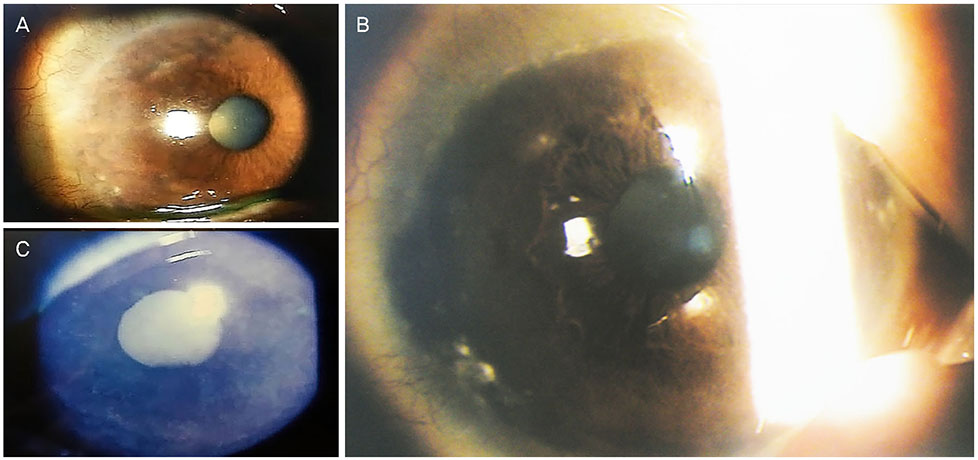J Korean Ophthalmol Soc.
2019 Feb;60(2):190-194. 10.3341/jkos.2019.60.2.190.
A Case of Toxic Keratoconjunctivitis by Self-application of Human Breast Milk
- Affiliations
-
- 1Department of Ophthalmology, Jeju National University School of Medicine, Jeju, Korea. amario@naver.com
- KMID: 2438080
- DOI: http://doi.org/10.3341/jkos.2019.60.2.190
Abstract
- PURPOSE
We report a case of toxic keratoconjunctivitis resulting from the self-application of human breast milk as a traditional folk remedy for allergic conjunctivitis.
CASE SUMMARY
An 82-year-old woman presented with pain and conjunctival hyperemia in the right eye that had been worsening for three days. Two months previously, she was treated with antiallergic eye drops for allergic conjunctivitis at another eye clinic. However, the symptoms did not improve. She applied her daughter-in-law's breast milk into her right eye as a folk remedy for three days. The pain and conjunctival hyperemia worsened. At the initial visit, her corrected visual acuity was 0.3 in the right eye. Slit lamp examination demonstrated conjunctival hyperemia, punctate epithelial erosion at the central cornea, corneal keratic precipitates and white-colored deposits in the peripheral cornea combined with irregularly shaped small nodules. There was no anterior chamber inflammation. There was no medical history of rheumatoid arthritis or tuberculosis. Blood tests for serum and other infectious and inflammatory levels for infection and inflammatory markers were performed followed by application of topical steroids and antibiotics with artificial tears. After 3 weeks of treatment, conjunctival hyperemia and corneal deposits had almost resolved and best-corrected visual acuity improved to 1.0.
CONCLUSIONS
The self-application of human breast milk may cause toxic keratoconjunctivitis. Therefore, efforts should be made, actively, to inform and educate the elderly in rural areas not to use human breast milk as a folk remedy.
MeSH Terms
-
Aged
Aged, 80 and over
Anterior Chamber
Anti-Bacterial Agents
Arthritis, Rheumatoid
Breast*
Conjunctivitis, Allergic
Cornea
Female
Hematologic Tests
Humans*
Hyperemia
Inflammation
Keratoconjunctivitis*
Lubricant Eye Drops
Medicine, Traditional
Milk, Human*
Ophthalmic Solutions
Slit Lamp
Steroids
Tuberculosis
Visual Acuity
Anti-Bacterial Agents
Lubricant Eye Drops
Ophthalmic Solutions
Steroids
Figure
Reference
-
1. West AL, Oren GA, Moroi SE. Evidence for the use of nutritional supplements and herbal medicines in common eye diseases. Am J Ophthalmol. 2006; 141:157–166.
Article2. Prajna NV, Pillai MR, Manimegalai TK, Srinivasan M. Use of traditional eye medicines by corneal ulcer patients presenting to a hospital in South India. Indian J Ophthalmol. 1999; 47:15–18.3. James M. Visual impact of using traditional medicine on the injured eye in Africa. Acta Trop. 1998; 70:185–192.4. Choudhary P, Chalisgaonkar C, Marathe N, Lakhtakia S. Use of traditional eye medicines by patients with corneal ulcer in India. Int J Med Sci Public Health. 2015; 4:1001–1005.
Article5. Ukponmwan CU, Momoh N. Incidence and complications of traditional eye medications in Nigeria in a teaching hospital. Middle East Afr J Ophthalmol. 2010; 17:315–319.
Article6. Ukponmwan CU, Okolo OT, Kayoma DH, Juliet EO. Complications of breast milk applications to the infected eye. Niger J Ophthalmol. 2009; 17:32–35.7. Ahmed M, Saeed M, Mahmood MA. Role of topical human milk in the treatment of neurotrophic corneal opacity. Pak J Ophthalmol. 2013; 29:225–230.8. Diego JL, Bidikov L, Pedler MG, et al. Effect of human milk as a treatment for dry eye syndrome in a mouse model. Mol Vis. 2016; 22:1095–1102.9. Asena L, Suveren EH, Karabay G, Dursun Altinors D. Human breast milk drops promote corneal epithelial wound healing. Curr Eye Res. 2017; 42:506–512.
Article10. Verd S. Switch from antibiotic eye drops to instillation of mother's milk drops as a treat ment of infant epiphora. J Trop Pediatr. 2007; 53:68–69.11. Pishva N, Mehryar M, Mahmoudi H, Farzan R. Application of topical breast milk for pre vention of neonatal conjunctivitis. Irn J Med Sci. 1998; 23:55.
- Full Text Links
- Actions
-
Cited
- CITED
-
- Close
- Share
- Similar articles
-
- A Study on Knowledges and Attitudes about Breast Milk Feeding and Needs for Breast Milk Feeding Education among High School Students
- Breast Milk for the Premature Baby
- A Study of Milk beta-Glucuronidase Activity in Breast Milk Associating with Neonatal Jaundice
- Exposure of Infants to Aflatoxin M1 from Mother's Breast Milk in Ilam, Western Iran
- Lipid Content of Breast Milk in Korean Women



